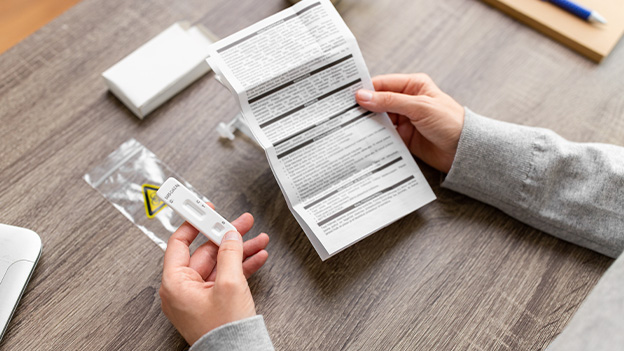With the improvement and enhancement of communication environments and the proliferation of devices such as smartphones, videos have transformed from something to enjoy watching to something individuals can create and publish. Platforms like YouTube, TikTok, and Instagram are overflowing with videos.

Of course, the quality varies from videos used in corporate advertising to those shot by individuals on their smartphones. Nevertheless, one thing that can be said in common is that videos themselves have now become the mainstream for information dissemination and knowledge enhancement.
Even just considering YouTube, there are many videos not only for entertainment but also for sharing how-tos and knowledge. Many people have likely searched for DIY projects or cooking recipes at least once.
It has become common to search the internet for things we don't understand, but nowadays, there seem to be quite a few people who narrow their searches down to videos from the start. This is because, with videos, one can listen to explanations while seeing the actual item, allowing for efficient understanding. Additionally, to meet such needs, there are likely more people producing and sharing videos that convey knowledge.
Table of Contents
1. Benefits of Using Video Manuals in Human Resource Training
2. Examples of Video Manual Production
2-1 [Case 1] Learning Video Manual for Construction Vehicle Inspection Methods
2-1-1 The Importance of Storyboarding in Creating Video Manuals
2-1-2 Effectively Conveying What Cannot Be Expressed with Text or Still Images Through Video
2-2 [Case 2] Video Manual for In-Store Staff Customer Service
2-2-1 Accurately Depicting Skilled Techniques by Allowing Performers to Follow the Cue Sheet
2-2-2 The Significance of Demonstration Videos
2-3 [Case 3] Video Manual for In-Store Staff Training
2-3-1 Video Manuals Are Effective for Training Foreign Workers
2-3-2 Videos Enable Understanding of Subtle Nuances in Customer Service
2-3-3 Enhancing Comprehension by Combining Video and Still Images
3. Summary on the Versatile Use of Video Manuals
1. Benefits of Using Video Manuals in Human Resource Training
In human resource development, educational materials utilizing videos are thriving. For example, information and skills that tend to be personal, such as the techniques of veteran experts, can be lost due to retirement and other reasons. In cases where we want to pass these on without losing them, video manuals are a very effective means.
The movements of veterans and the use of tools cannot be fully expressed with words alone. On the other hand, by recording actual actions and operations and supplementing them with explanations as needed, we can create educational materials that can be learned visually. Additionally, if the data is in video format, it becomes easier to share and distribute online.
In general, videos tend to have large data sizes, but in today's well-equipped communication environment, this is not such a serious hindrance. Rather, because they are visual, they are utilized as a medium that allows for detailed confirmation and preservation. Furthermore, by adding explanations, they can become useful teaching materials that are easier to understand and more memorable. Nuances that are difficult to explain with words can be intuitively understood through video.
Rather than thinking about various things, you can first learn by imitating model videos, understanding the situations conveyed in the videos, and this form of learning can be realized through video.
Of course, it depends on the subject matter, but when it comes to skill acquisition and inheritance, manuals that utilize videos can be considered more effective compared to paper manuals that present procedures in words.
As mentioned above, video manuals have the significant advantage of being able to record and view actual operations as they are. This is effective not only in manufacturing sites where technical skills are required but also in situations such as learning operational procedures in the retail industry.
In the retail industry, regardless of the type of business, there is a mountain of information that one person must learn before they can become independent. They must memorize a vast amount of information, such as how to operate the systems and equipment used, as well as the daily business procedures, all within a limited time.
In such cases, utilizing video manuals can efficiently convey important information and facilitate effective learning. For example, by providing instructions on product restocking, display methods, and handling of products as video manuals, visual learning can be achieved. Since the focus is on visual information, extensive explanations are not necessary, allowing for a reduction in the amount of text and words used.

On the contrary, what if we explain using only words without any visuals? Each learner may interpret it differently. In such a situation, when it comes to practice, there may be inconsistencies in responses, resulting in an inability to act according to the manual.
In that regard, with video manuals, learners can study by watching exemplary performances. By practicing the steps and actions as explained in the video, learners can get closer to the ideal form intended by the manual.
What is mentioned here is just one example, but depending on the subject matter being studied, it may be more suitable to learn by actually seeing it rather than listening to detailed explanations in lectures, and this can sometimes enhance the learner's understanding.
I believe that for those who, like me, find it difficult to follow text visually, learning through videos has the advantage of being easier to remember.
2. Video Manual Production Examples
2-1 [Case 1] Construction Vehicle Inspection Method Learning Video Manual
The first introduction is a construction vehicle inspection manual video created at the request of a major electronics company. This client was using paper manuals for pre-learning in their business training, but decided to prepare a video-based manual to facilitate smoother understanding for learners.
The completed video contains the following content.
We capture actual vehicles from various angles and provide video explanations of the operating equipment and actual inspection methods.
In addition, to help understand the importance of inspections, we recreate actual accidents in a dramatized format to raise awareness and convey the serious impacts of accidents. By showing real site photos and reports, we aim to create a realistic experience, learn lessons from accidents, prevent disasters from fading away, and create a video manual that can be utilized in the future.
2-1-1 The Importance of Storyboarding in Video Manual Creation
A storyboard is the overall scenario of the completed video and is involved in the entire process. By creating a storyboard, you can grasp the overall picture of the video manual. Additionally, it clarifies what to shoot and from what angles, making it important for efficient filming.
The information necessary for video editing after filming, such as direction, subtitles, timing between visuals and narration, and various other details, is all included in the storyboard. In this way, the storyboard is a very important element in the production of video manuals.
So, what specifically is written in the storyboard?
To create a storyboard, first, the overall story is determined. After that, the content of each scene is devised.

The image of the video displayed on the screen is essential. In this project, we created rough illustrations of the inspection items (locations, actions) and transcribed the points to emphasize in each scene, as well as the explanations to be included as narration.
The narration phrasing is written by professional scriptwriters, but important points and word usage that we want to convey to learners are confirmed with the client's representatives who are actually involved in the field, and the wording is refined. All stakeholders check whether the intentions of the teaching side are incorporated into the storyboard and whether important points are emphasized, and we refine it together. Once the storyboard is completed through these processes, we can finally proceed to filming on site.
2-1-2 Production Point 2: Effectively express what cannot be conveyed through text and still images with video
Reflecting the Craftsmanship in Video
We will film the inspection and operation of actual work vehicles according to the storyboard.
Filming will generally proceed according to the storyboard. However, while filming with explanations from the on-site personnel, there may be instances where we receive opinions or requests regarding unexpected angles or additional tasks not included in the storyboard.
Therefore, even after entering the filming process, it is not uncommon for changes to be made to the storyboard, and rather, the refinement continues while incorporating valuable feedback.
During the shoot, the on-site personnel will indicate important learning points (such as equipment locations) on the spot, and we will proceed with several camera angles. This is to select footage that is easier to understand during editing. By shooting from multiple angles and utilizing them for explanations, we can confirm details such as the actual body orientation and hand placement, leading to a deeper understanding.
In this project, since the equipment being handled is large, we made sure to capture the actual application of force and how weight is applied. By making efforts to ensure that even the finer details can be understood in this way, we create a manual that is intuitive and easy to understand, resulting in a high learning effect without the need for extensive explanations.

For example, by showing videos of inspections such as dirt at the joints of equipment and oil leak checks, as well as checking the connection points of the equipment, one can develop a sense of the level of judgment criteria during inspections. Additionally, by recording the movements of workers from a wide angle during safety inspections, it becomes easier to visualize the distance and positioning relative to vehicles.
Video manuals that include such content are utilized in field operations, helping learners to smoothly adapt to the site.
2-2 [Case 2] In-Store Staff Response Video Manual
Next, we would like to introduce a request from a company that sells shoes nationwide. We produced a video manual for use in their stores.
In many cases, video manuals used in stores focus on customer service by store staff, product replenishment, and inventory management, but in this project, we also covered shoe maintenance.
2-2-1 Accurately depicting skilled techniques by allowing the performer to take charge while using the cue sheet
In this project, we had actual store staff participate and filmed their actions. Of course, the individuals who acted are experienced professionals. Therefore, there was no need to provide detailed instructions for their movements, and the creation of storyboards was omitted.
What we have prepared instead is the "Koban Table". The Koban Table is similar to a schedule used in drama filming, detailing the order in which each scene will be shot, the tools and angles to be used, and notes on who will do what.
For example, when depicting a character's day, the scenes switch from home → commute → company → commute → home. However, if filmed in chronological order, it would require changing sets and costumes each time, which is inefficient. To resolve this, we create a shooting schedule that groups scenes requiring the same set, such as home or commute, and ensures that no necessary props are overlooked. In this project, we efficiently progressed by consolidating shoots that used the same props, utilizing the shooting schedule.
And, the operation is basically left to the performer. The detailed "hand movements" of shoe maintenance are entirely based on the movements of the model performer. This video truly depends on the performer's movements. We will proceed while capturing the skilled performer's "hand movements" as they are.
Significance of Being a Demonstration Video

There is also a paper manual for shoe maintenance, which provides detailed explanations using photos and illustrations.
However, learning through video manuals demonstrated by skilled professionals can be expected to have a greater effect.
How to apply shoe cream, how to use a brush, how to hold shoes, and how to align your gaze are all clearly demonstrated in the instructional videos. Learners can directly observe a series of exemplary actions and achieve a higher learning effect.
For example, in this project, we created a video to verify the effectiveness of a waterproof spray. We prepared leather materials treated with the waterproof spray and untreated leather materials to compare their effectiveness. On e-commerce sites, you often see comparison photos of the materials after water is applied, but a video can enhance the appeal even further. In other words, we can recreate the actual application of water and demonstrate the effects that are exhibited.
In the completed video, it is clear how much water flows, how much it repels water, and the state of the water that splashes around. By showing not only the results but also the process, learners can experience the effectiveness of the waterproof spray. The experience through the video can be utilized for persuasive customer service. This learning effect can also be considered an advantage of video manuals.
Of course, for the store staff, it has become a video manual that not only teaches them how to maintain shoes but also helps them understand the importance of maintenance and why it is necessary, fostering a sense of attachment to the shoes.
Store staff learning with the completed video manual are able to feel the necessary know-how for selling shoes, maintenance techniques, and the excellence of the products they handle, allowing them to approach customer service with enthusiasm.
2-3 [Case 3] Video Manual for In-Store Staff Training
In this case study, we have created a video manual for the customer service and product handling of convenience store staff. Of course, video manuals also have a significant learning effect when it comes to learning the operations of a convenience store.
The operations at convenience stores are diverse. They include customer service at the register, stocking and displaying products, preparing deli items, receiving packages, payment processing services, and various ticket sales. Recently, they have even started handling tax payments. Convenience store staff must learn a wide range of tasks in a short period of time.
We received requests from our customers to have their staff effectively learn the necessary tasks in a short amount of time, which led us to create video manuals.
2-3-1 Video manuals are effective for training foreign workers
The originally created business manual was explained clearly with illustrations, making it easy to understand. It has been designed to help newly hired employees learn the business content in a short time and be able to work in the actual store.
What was the reason for preparing a video manual despite having a manual in place? During the hearing when starting the project, the response from the person in charge was about care for foreign workers.
Many people may have experienced this, but recently, there has been an increase in foreign staff at convenience stores. While their Japanese language skills are sufficient and there are no issues with customer service, it seems that misunderstandings due to nuances in language often occur, making it difficult for intentions to be conveyed.

It seems that there are surprisingly many things that, while relatively easy for Japanese people to understand based on context and experience, can be difficult for foreigners to grasp. Additionally, even with sufficient Japanese language skills, one cannot avoid specialized terminology and industry jargon when engaging in work.
It was said that due to the customer's intention to eliminate such barriers as much as possible, they decided to prepare highly effective video manuals that allow learning to progress without relying on words.
Indeed, as the saying goes, "Seeing is believing," video manuals are educational materials that convey information visually. They do not rely on verbal explanations, focusing instead on demonstration videos, making them particularly effective for training foreign workers. With the recent increase in foreign workers, it has become evident that video manuals are being utilized more and more.
2-3-2 Because it's a video, you can understand the subtle nuances of customer service.
According to what we heard from the person in charge, the customer service attitude of Japanese store clerks is reputed to be exceptionally good, standing out even in the world. However, it seems that for foreign customers, it can sometimes be difficult to understand such service practices, leading to questions about whether it is necessary to go that far.
For example, even the order in which products are placed in a shopping bag can reflect differences in countries and cultures. There were reports of incidents such as bread being crushed because it was placed at the bottom, sharp or hard items puncturing the bag, and products spilling out due to shifting within the bag. To avoid such "incidents," it seems that showing a model performance through a video manual helps people understand the correct method more smoothly. Subtle nuances such as the orientation and angle when placing items in the bag can be easily understood through video, eliminating misinterpretations. For instance, the method of placing a milk carton horizontally in a way that does not tear the shopping bag is something that can only be effectively conveyed through video.
One of the major advantages of video manuals is that you can learn by looking at the key points to keep in mind for each action.
2-3-3 Enhancing Understanding Colors with a Hybrid of Video and Still Images
In this project, illustrations and still images were also used in the video. Specifically, key points are highlighted by inserting captions.
This company also handles fresh produce in-store, and the freshness of the products is one of the selling points. Therefore, the condition of the products must always be checked and assessed. This video manual compares the condition of products that are acceptable with those that should be removed, using photographs. While explanations can be provided through video and narration, still images were intentionally used in scenarios where learning about key points and important considerations, as well as the criteria for assessing product quality, is necessary.
For example, we show an overall view of the vegetables in photos and explain the points from various angles. Since still images provide less visual information than videos, we can use them to highlight key points. This allows learners to observe the subject closely. Additionally, important notes are displayed in bullet points to emphasize key points and help them be retained in written form.
We have created educational materials that allow you to fully learn the necessary information for your work by watching videos, listening to explanations, observing still images, and supplementing with text.
3. Summary of Utilizing Video Manuals
Video manuals are utilized across various industries. There may be cases where the necessity of using a video is questionable.
If you are considering the production of video manuals, it is important to determine what format is appropriate, including the production period and costs.
Whether to create a booklet as a paper manual or to distribute data in electronic media such as PDF, regardless of the video, we must carefully consider and examine the ways and purposes of utilizing the manual. Depending on the production method, it may also be necessary to consider the use of external resources.
> Video Manual Production Service (https://www.science.co.jp/document/movie.html)

Author:
Kensuke Yoshida
\nEducation Solutions Department, Production Group
\nProduction Director / Learning Consultant
\n ・Director of e-Learning Content Production, 15 years of experience
\n ・Involved in large-scale projects including Flash to HTML5 conversion and LMS development
\n ・Engaged in video content production utilizing video and multilingualization of video content
\n ・Learning Consultant (eLC Certified e-Learning Professional)
Contact Information:
Phone Number: 03-5321-3111
hsweb_inquiry@science.co.jp
Related Blog Posts
- Most Popular
-
-
- Category

























